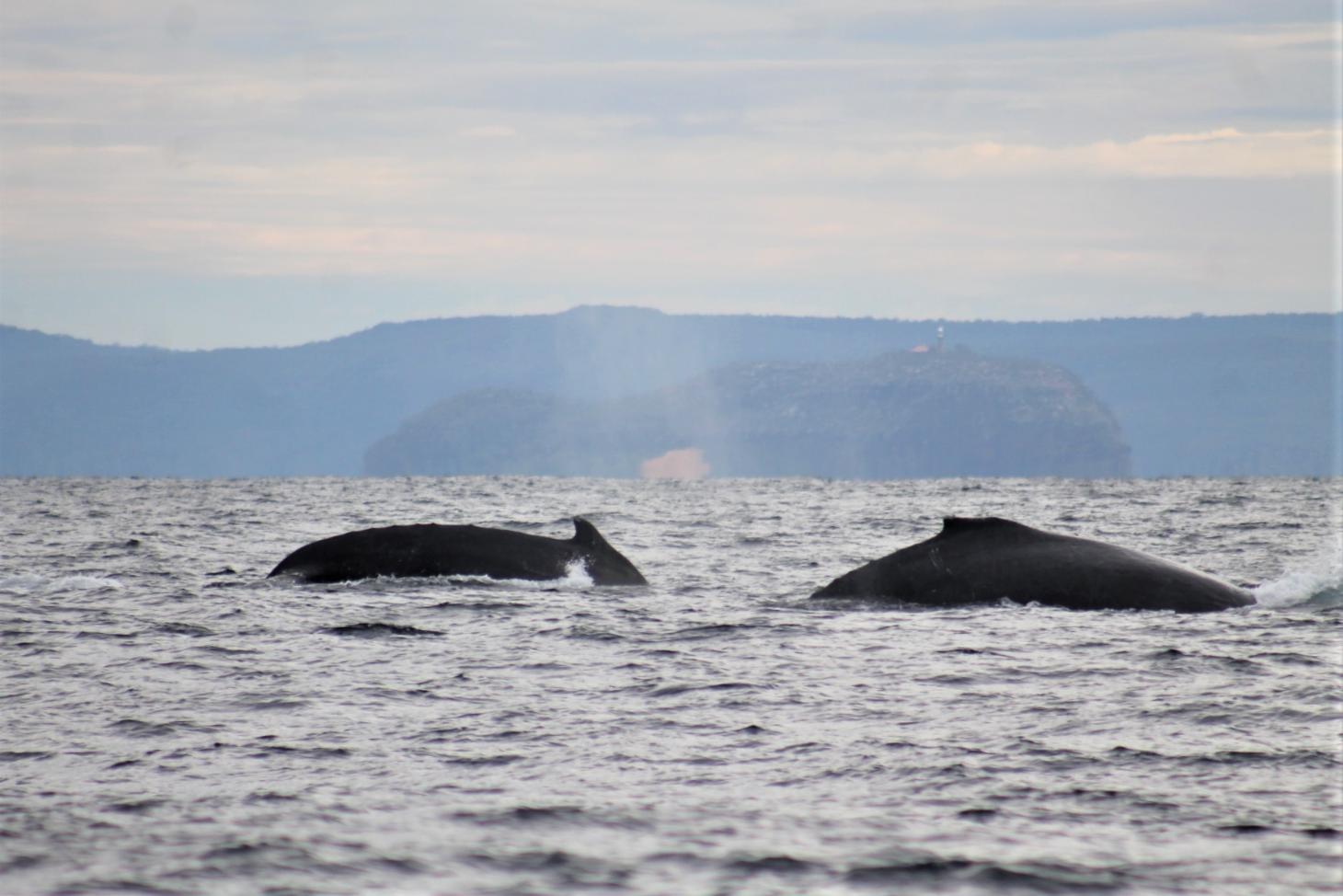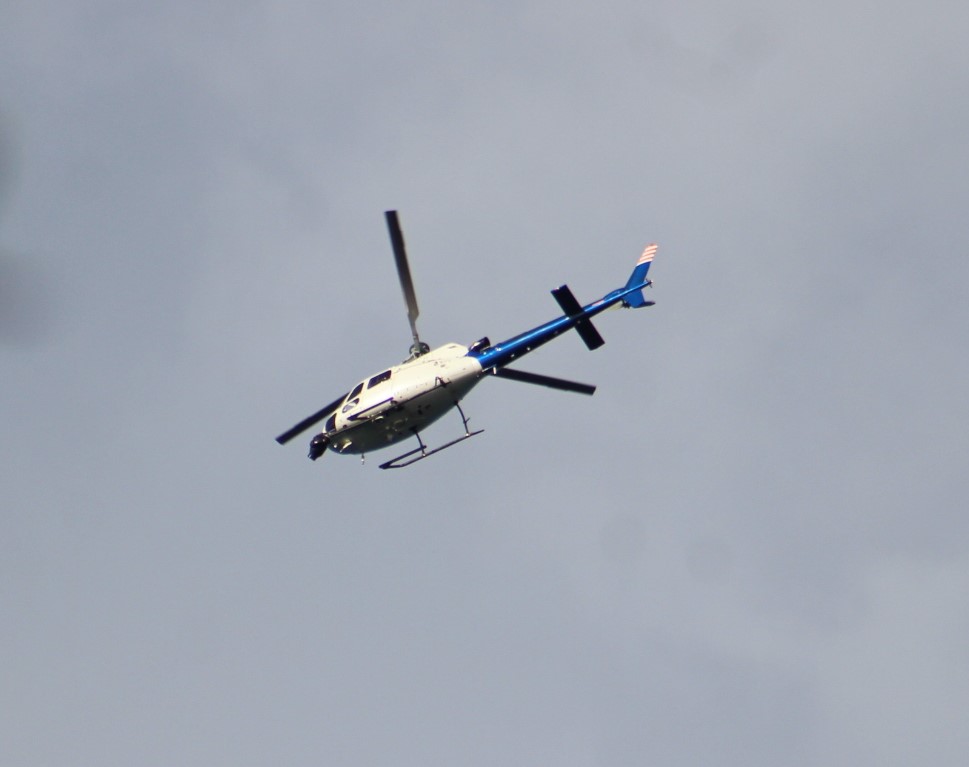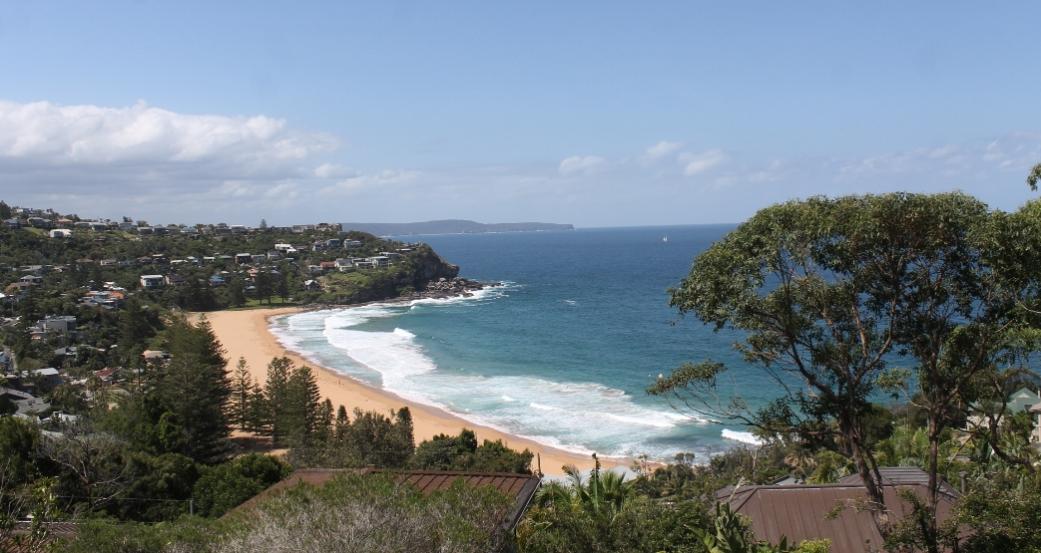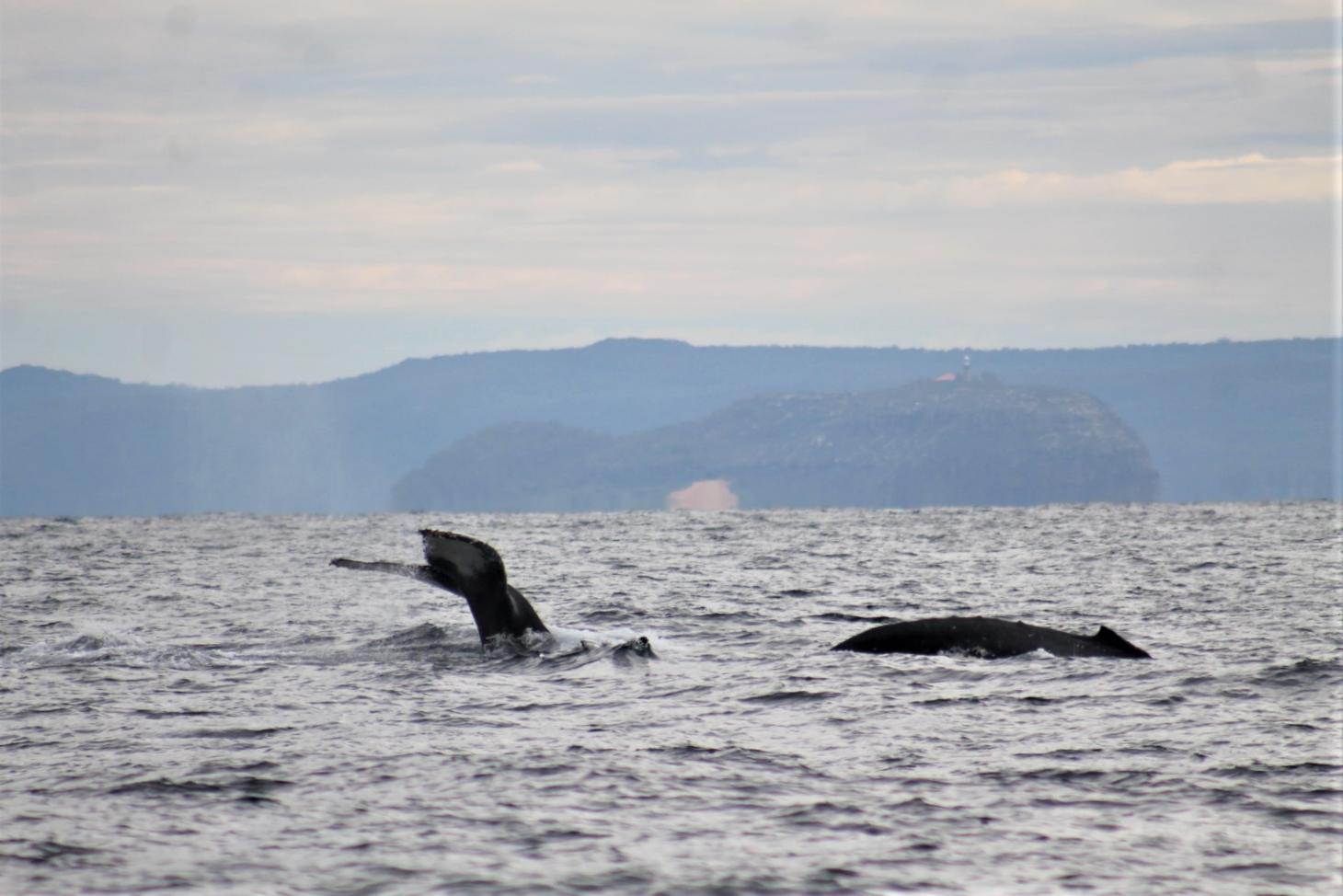October 17 - 23, 2021: Issue 514
Juvenile Humpback Whale Caught in Shark Net off Whale Beach Renews Community Calls for Shark Nets to Not be installed until the Southern Migration ends

Mothers and younger whales come closer to shore on their southern migration to rest.
The entanglement came only hours after a pregnant bronze whaler shark was freed off Mona Vale beach.
Marine Rescue Broken Bay was tasked with responding and ferried a member of the NSW National Parks and Wildlife to meet other members of a NSW National Parks and Wildlife Service (NPWS) specialist whale disentanglement team off the beach.
Fortunately, at 7.10 pm, in fading light and strong winds, the NPWS Team were able to disentangle this juvenile humpback whale.
The incident has renewed calls by thousands of residents in the local community, and by thousands watching online, for shark nets to be removed and not installed until after the southern migration of whales along our coast finishes, stated to run until November each year.
The official whale watching season commences June 1st although whales will be seen heading north long before then.
This year, on Tuesday June 1st 2021 the ORRCA Research Team observed and confirmed an entangled Humpback whale off Miners Beach at Port Macquarie. This was a young whale, around 7-8m, trailing 200m of rope to which was attached 3 white buoys and 1 orange buoy.
On Wednesday June 2nd 2021 the ORRCA Research Team have observed and confirmed another entangled Humpback whale off Port Macquarie. This time it was 3 whales out about 2km off shore, with the smallest whale having a rope around its dorsal fin with a white buoy a few metres behind it. The young whale from the day before had been spotted further north at Coffs Harbour, still entangled, with rescue teams considering options as to what they could do.
Fortunately, late on Friday the Sea World rescue crew intercepted the young whale off Evans Head and removed most of the ropes and gear. These whales had been preceded by sightings on Sunday May 16th of an entangled whale off Sydney which, in this instance, freed itself and were followed by another being entangled on June 6th. This end of the first week of official whale watching entanglement was reported by Marine Rescue NSW with the NSW Water Police managing to remove part of the netting before it swam off, heading north.
Discarded fishing gear, nets and ropes, plague whales as they head north and by the time they're heading south again, shark nets, installed off NSW beaches on September 1st each year, can wreak havoc on returning bubs and youngsters.
The NSW Shark Meshing (Bather Protection) Program 2020/21 Annual Performance Report records two humpback whales were caught in shark mesh off our shores, both released alive. The report shows a total of 375 marine animals were caught in the SMP during the 2020/21 meshing season, comprised of 40 target sharks and 335 non-target species, including threatened and protected species - all 8 of the Green Turtles found in nets were dead, as were 5 Common Dolphins.
This year, fortuitously, the East Australian Current (EAC) has been further offshore - whales use this as a navigation tool so Queensland researchers have been seen in pods 10 and 15 kilometres out from shore. Those who went looking from headlands at the beginning of June could see they were further out and this recurred in the Queensland waters, returning south, throughout September.
Further south, for the past several weeks, people from Terrigal to Manly have seen a literal streaming of whales heading south every single day, many coming closer to shore. The photos shared Friday and Saturday October 15th and 16th have been spectacular - but they also show the whales, at least in the New South Wales part of their odyssey south, are coming closer to shore in order for these images to be made.
In March 2021 the NSW Department of Environment announced NSW National Parks and Wildlife Service (NPWS) specialist whale disentanglement team were out on the water recently honing their skills ahead of the annual humpback migration season.
Ms Mel Hall from the NPWS said around 20 staff undertook training on how to safely free a large whale tangled in ropes and buoys.
"Any attempt to disentangle a distressed whale is inherently dangerous and complicated by changing sea conditions, the enormous size of the whale and its instinctive behaviours," said Ms Hall.
"Only highly trained, specialist teams should attempt to free a trapped whale and our goal with this training is to make sure our staff are equipped and ready to respond.
"Just before the humpback migration season every year we undertake this 2-day training that includes working in inflatable vessels to free a 4-metre inflatable 'whale tail' entangled in lines and ropes.
"Staff are also trained to attach satellite tracking devices to an entangled animal to help teams track and relocate the whale in case an immediate rescue is not possible.
"The team's surf skills are also put to the test to make sure we have the most experienced and capable rescue team on the job," said Ms Hall.
Last year NPWS successfully freed an entangled humpback whale off Royal National Park.
"This was a long and complex operation where rescue crews relied on their training and experience to safely cut the animal free from lines and ropes around its head and tail," said Ms Hall.
"We were fortunate that the conditions were right for the NPWS team to safety launch vessels, approach the whale and cut it free," said Ms Hall.
The annual whale count numbers have been steadily increasing by around 10% each year, which is extremely good news.
But naturally with more whales moving along our coast we can only expect that more may become entangled in fishing gear, wash up onto our beaches or be struck by boats.
"The best way for people to help these animals is to immediately report any sightings of entangled or distressed whales to authorities.
"Anyone who sees a distressed or entangled whale should not attempt to free it but call NPWS on 13000PARKS (1300 072 757) or ORRCA on 02 9415 3333," said Ms Hall.
The Sydney based NPWS whale disentanglement team is one of several along the NSW coast trained to intervene if an animal is reported in distress.
The sheer joy and jubilation the team who worked at Whale Beach showed after they freed this young humpback on Saturday was echoed by all watching from the beach or waiting for news on social media.
This was no easy task as the whale, completely stuck in a net anchored to the sea floor, could become more distressed and exhausted as the hours wore on.
Added to this a very loud helicopter, hovering for hours over the headlands above Dolphin Crescent and further north, which make louder through the natural resonance of bays with stone in their hills any noise, and there for commercial media reasons only, for profit, must also have impacted on the trapped whale - it certainly annoyed and added to fears for the whale, just by the persistence reason for its presence, all the residences it hovered over for hours.

A person operating a helicopter or gyrocopter in the vicinity of whales and dolphins must not:
- fly lower than 500m within a 500m radius of a whale or dolphin; and
- approach a whale or dolphin from head on.
In some instances such as for scientific or educational purposes, or commercial filming it may be necessary for aircraft to approach closer to a whale or dolphin than outlined in the EPBC Regulations or state and territory regulations. This may only occur under the authorisation of the relevant state, territory or Commonwealth authority. In these cases all aircraft must operate within the conditions of the authorisation.
However, these regulations are not taking into account the deafening noise helicopters make within sheltered bays which will amplify the volume. Whale studies have shown these cetaceans are particularly sensitive to noise; it can interfere with their communication and affect their behaviour.
When sound produced in the air is transmitted to water, a large amount of sound energy is reflected off the water. Only waves that strike the water at a near-vertical angle are actually transmitted into the aquatic environment. In water, sound waves travel four to five times faster than in air.
A study conducted in the Beaufort Sea in northern Alaska compared the reactions of belugas and bowhead whales to aircraft and helicopter noise during spring migration to the feeding ground. In both species, the types of reactions, when present, were similar: reduced surface time, precipitous dives, sudden changes in direction or movement away from the noise source.
In a similar study, a group of sperm whales behaved unusually after an aircraft circled above them for several minutes: the 11 sperm whales gathered in a semicircle facing outwards. The largest male in the group positioned himself towards one end, while the only calf of the group stayed in the centre of the curve. This type of formation is sometimes observed during real threats, such as killer whales, sharks and whalers. [3.,4.,5.]
You have to wonder how much this horrible LOUD noise, that went on for hours, affected this lone young whale.
How much help was this to the rescuers as well?
In New South Wales you must not fly a drone within 100 m of marine mammals, with migrating whales particularly noted. If you do, you can be fined up $3300 - fines are up to $110,000 for doing so were spoken of in August 2017 - as explained in this Manly Daily report by John Morecombe.
On July 29 2021 a new whale monitoring program, that uses drone technology to monitor, track and ID southern right whales off the NSW coast, was announced as delivering spectacular results during this year's whale migration season.
Environment Minister, Matt Kean said then the Right Whale ID citizen science project program enables researchers to identify and track NSW's endangered southern right whales.
"We are seeing some truly spectacular images and vision of these precious and endangered animals, only this week we have been tracking two pairs of southern rights in Jervis Bay, south of Sydney," Mr Kean said.
"We can see from their behaviour they use our city bays and estuaries as a kind of pre-school where they teach their calves how to breach and feed before heading off to Antarctica for the summer."
Unlike humpback whales, south eastern southern right whales do not complete the 'humpback highway' and motor past us to Queensland waters. Instead they prefer to hang out in NSW's coastal bays and beaches to breed and give birth. Every southern right whale, even the calves, have white hardened skin patches called callosities on their heads that create distinct, individual patterns. Analysis of the photos from the drones is then used to build up a library of images to identify individuals year on year and better understand their movements.
This new pilot program involves National Parks and Wildlife Service (NPWS) sending out a CASA (Civil Aviation Safety Authority) accredited drone operators who are trained to observe the safe legal marine mammal approach distances.
Six out of eight council areas that have shark nets on their ocean beaches, including the Northern Beaches, Newcastle, Waverely, Randwick, Central Coast, and Wollongong councils, voted earlier this year to submit to the NSW Department of Primary Industries that they no longer want shark nets deployed on their ocean beaches out of concern for the environmental impacts.
Sydney coastal councils’ aversion towards shark nets is shared by the public and these LGA's residents. In Department of Primary Industries (DPI) surveys of NSW residents, shark nets consistently finish dead last in a ranking of preferred shark bite mitigation methods.
New South Wales’ Shark Meshing Program, currently consisting of 51 shark nets spanning from Newcastle to Wollongong, had not updated its methods during its 100 years of operation despite significant technological and scientific advancements that have been tested and proven effective in the state.
Shark nets, usually 150 meters long and 6 meters high, provide a false sense of security for ocean users. Forty percent of sharks are caught on the beach side of the nets [1] and during the nearly 100 years that shark nets have been in use in NSW, there have been 34 unprovoked human-shark interactions at netted beaches in NSW [2].
These nets indiscriminately catch marine life, often killing those that become entangled. Even those that are freed suffer from extreme stress and may not survive.
Since 2012 the New South Wales nets have caught approximately 3375 marine animals, including threatened species of dolphins, whales, and turtles, killing over 1830 (54%) [2].
Modern solutions to bather protection, including drone surveillance, SMART drumlines, personal shark deterrents, and accessible education programs, are not only more technologically advanced but are also designed with nearly a century of advancements in understanding shark behaviour in mind.
On September 19, 2021 the NSW Department of Primary Industries announced 'the world’s largest suite of shark management tools and technologies will be deployed to NSW beaches after funding was nearly tripled to $21.4 million to expand the NSW Government’s Shark Management Program'.
Then Deputy Premier and Minister for Regional NSW John Barilaro said this increased funding would support the expansion of the effective, evidence-based shark management program already in place, with a host of successfully trialled technologies to be rolled out along the NSW coastline.
“The NSW Government has done the research and invested in new technologies to bring added protection to our beaches including SMART drumlines, VR4G listening stations and shark-spotting drones,” Mr Barilaro said.
“Over the coming weeks we will continue to work with coastal councils from Tweed to Bega Valley and everywhere in between to deliver the world’s largest shark management program to increase beachgoer safety.
“There is no other jurisdiction in Australia or across the globe which has done as much testing and trialling of technology and approaches to mitigate shark interactions.”
Minister for Agriculture Adam Marshall said the NSW Government is committed to doing everything possible to keep swimmers and surfers safe while minimising the impact on marine life by using non-invasive technologies where possible.
“We have always said there is no silver bullet when it comes to protecting beachgoers from sharks in NSW,” Mr Marshall said. “But the NSW Government will now be operating the world’s largest shark management program aiming to get the balance right, between keeping swimmers and surfers safe, and protecting our marine life.
“In partnership with Surf Life Saving NSW, we will deploying the world’s largest domestic fleet of drones to the state’s beaches thanks to an extra $3 million to scale up operations. This will mean more than 50 beaches will have a shark-spotting eye in the sky.
“This summer season, we will be deploying over 100 SMART drumlines in nearly every coastal council area starting with Kingscliff, Tuncurry and Coffs Harbour next month.
“We will also continue the deployment of shark nets as part of the Shark Meshing Program in the Greater Sydney Region while we measure the success of the expanded technology-led solutions.
“Finally, we will be blanketing our coast with 37 VR4G shark listening stations to make sure that when a tagged shark comes close to the coast, everyone using our SharkSmart app will know about it instantaneously, including SLS NSW and council lifeguards.”
The NSW Government encourages all beachgoers to be SharkSmart when entering the ocean or estuarine environments and download the SharkSmart app.
Once more: data from the NSW Shark Meshing (Bather Protection) Program 2020/21 Annual Performance Report records 375 marine animals were caught in the SMP during the 2020/21 meshing season, comprised of 40 target sharks and 335 non-target species.
Saturday's four long hours of work by the teams involved was a triumph for all the training and advances the NPWS and NSW Government have accomplished in recent years, it made heroes of the National Parks and Wildlife Service (NPWS) specialist whale disentanglement team members who will now ever be beloved in Pittwater, saw Whale Beach SLSC members rising, as always, to the challenge presented, Marine Rescue Broken Bay volunteers being the quiet legends we all know they are, and local ORRCA volunteer members co-ordinate all teams while their volunteers on the ORRCA hotline, as always - every present, ever poised to put their training top use to save marine life.
However, the community wants the shark nets gone until the whale migration season has finished.
The rules for helicopters hovering for hours in reverberating landscapes meeting foreshores, just so they can commercialise and profit from whales in danger and distress them further, may need some updating too.
''Yesterday afternoon we spent frustrating hours watching a young whale stuck in the 'shark' net at Whale Beach. Struggling to breathe.
As you may know, or not...these nets are designed as a placebo for our hyped up fear of sharks, and they do zero to manage that species and in fact destroy a wide spectrum of other species.
Sydney local councils, Living Ocean, ORRCA, Humane Society International Australia, the Australian Marine Conservation Society and more have all called for the concept to be scrapped in favour of other 'smarter' ways to protect ocean swimming humans. The irony here is we are actually the problem.
We KNOW that on the southern migration, mother and calf Humpbacks swim south close to the coast late spring. Lots of reasons for them to do this. We also know the time frame for when they do this. So to place whale traps directly in their path is some sort of insanity.
At current global pricing this young whale yesterday, is worth very close to US$ 5.4 million in terms of carbon capture. Our Humpbacks sequester carbon and help modify our overheating climate like nothing else except trees and we have taken 50% of the trees from Australia since Europeans arrived here and set up.''
Robbi Luscombe-Newman
Living Ocean
Co founder, President.
Anyone who sees a distressed or entangled whale should not attempt to free it but call NPWS on 13000PARKS (1300 072 757) or ORRCA on 02 9415 3333.
Marine Rescue NSW
16 October 2021
Smiles all around this evening as just before the loss of the light the juvenile Humpback whale was successfully freed from the netting it was entangled in.
Great work by the NSW National Parks and Wildlife Service and Marine Rescue Broken Bay.
References:
- McPhee, D. 2012. Likely effectiveness of netting or other capture programs as a shark hazard mitigation strategy in Western Australia
- Sjark Smart, NSW DPI https://www.sharksmart.nsw.gov.au/shark-nets
- Castellote, M., B. Thayre, M. Mahoney, J. Mondragon, M. O. Lammers et R. J. Small. Anthropogenic Noise and the Endangered Cook Inlet Beluga Whale, Delphinapterus leucas: Acoustic Considerations for Management. (États-Unis). Marine Fisheries Review 80(3) : 63. 2019. DOI:10.7755/MFR.80.3.3
- Smultea, M. A., J. R. Mobley Jr., D. Fertl and G. L. Fulling. 2008. An Unusual Reaction and Other Observations of Sperm Whales Near Fixed-Wing Aircraft. Gulf and Caribbean Research 20 (1): 75-80. Retrieved from https://aquila.usm.edu/gcr/vol20/iss1/10 DOI: https://doi.org/10.18785/gcr.2001.10
- Patenaude, J. P., W. J., Richardson, M. A. Smultea, W. R. Koski et G. W. Miller. Aircraft sound and disturbance to bowhead and beluga whales during spring migration in the alaskan Beaufort Sea. 2002. Marine Mammal Science 18(2) : 309-335.
- 10 facts about deforestation in Australia - from www.wilderness.org.au/news-events/10-facts-about-deforestation-in-australia

